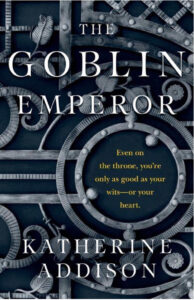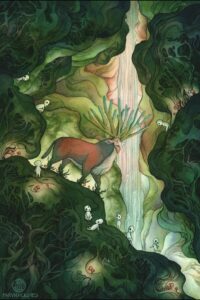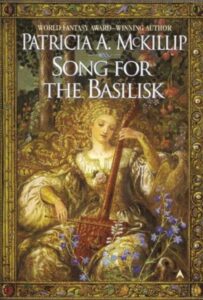If you’re a typical Hayao Miyazaki fan, you probably wish there were more stories like his out there. It’s a problem I think about often. I wish I could find more movies, music, video games, and books for Miyazaki fans like me.
There’s really no way to perfectly fit another story–movie, book, or other format–into a perfectly Miyazaki-shaped picture frame. That said, there are stories out there that strike a similar chord or share traits Miyazaki fans will probably recognize and care about. Here are just seven books that have done that for me:
- The Goblin Emperor by Katherine Addison
- Sabriel by Garth Nix
- Binti by Nnedi Okorafor
- The Word for World is Forest by Ursula K. Le Guin
- Dragonsong by Anne McCaffrey
- Song for the Basilisk by Patricia McKillip
- Spinning Silver by Naomi Novik
1. The Goblin Emperor by Katherine Addison (2014)

The title The Goblin Emperor probably conjures images of a muscled creature ruling with a heavy hand. But that’s not what Katherine Addison’s novel is about. Her goblins are pretty much just mortal elves, and this book’s emperor would rather build socioeconomic infrastructure than serve Sauron.
Miyazaki would probably love the steampunk, airship-filled world Addison has created. Yet what makes The Goblin Emperor so reminiscent of Miyazaki is not the story or even the setting. It’s the presentation that sets this book apart.
The novel is very concerned with death, loneliness, selfish politicking, and intrigue. It also manages to be a hopeful, positive story about trusting people, observing healthy boundaries, and coming of age without becoming inured to the very real darkness in the world. The optimistic direction of this book is a particular strength, one which Miyazaki fans will likely recognize with familiarity.
What it reads like: Howl’s Moving Castle as a casual murder mystery about blue collar political programs.
2. Sabriel by Garth Nix (1995)

Sabriel is a story about boarding school, boats and magic airplanes, death bells, courageous daughters, and rabbit necromancy. And, like so many Miyazaki movies with equally suspect content topics, it seems to have kids in mind as its primary audience.
Sabriel delves unabashedly into dark, complex themes often brushed behind the curtains in media for middle grade and young adults. The most obvious themes have to do with death and grief. A large portion of the novel’s worldbuilding concerns the relationship between those who are alive and those who are not. Instead of leaning into the eeriness or sorrow these themes invoke, however, Sabriel explores them through the lens of its beautifully unique setting.

The novel contains a very Miyazaki-like protagonist, a keen interest in natural elements like earth and water, and even a flying scene (almost a must for Miyazaki). But it’s Garth Nix’s focus on the weirdly beautiful that makes Sabriel most like a Miyazaki movie.
What it reads like: Spirited Away meets Diablo II’s necromancer class (but for young readers).
3. Binti by Nnedi Okorafor (2015)

Despite its sometimes categorization as science fiction horror, Binti brings so many elements together that Miyazaki fans are likely to love.
First, it follows the title character on her journey away from home to attend a prestigious university. Binti is the first of her ethnic group ever to enter said university, which opens her circumstances to numerous challenges and prejudices. If a brave girl who loves math and sets out on her own in a flying whale doesn’t sound like something Miyazaki would depict, I’m not sure what does.
Second, the character Binti shares some of the more subtle characteristics of many Miyazaki heroines. Like Nausicaä, Sheeta, San, Fio, or Sophie in particular, Binti has a knack for making friends of her seeming enemies. This alone brings an incredible positivity to her story, despite many moments of terror and isolation.
Third, Binti as a work doesn’t linger over its darker moments. The story stops for breath, instead, in instances of great imagination and beauty. The cadence of the novella thus parallels virtually every Miyazaki movie, using a distinctly unHollywood approach to both plot and pacing.
Fourth, like several of Miyazaki’s films, Binti is a story with no clearly personified villain. It’s thus is a story that doesn’t rely on violence or death for a final resolution. Rather, the climax of the tale relies on healing and unification born from a deep respect both for scientific learning and age-old tradition. Binti’s reverence toward wisdom and learning from both sources (often viewed as opposing ones) might be the most Miyazaki-like element of all.
What it reads like: Nausicaä of the Valley of the Wind before everyone loves the heroine.

4. The Word for World is Forest by Ursula K. Le Guin (1972)

If you’re a Miyazaki fan, you’ll probably know that no less than four of Ursula K. Le Guin’s novels have been adapted–by Goro Miyazaki, not Hayao. The much disparaged Tales from Earthsea liberally combines and modifies material from Le Guin’s Earthsea Cycle. It scrunches four books’ contents into one movie that truly approximates none of them. The point isn’t to lament that Goro’s directorial debut is not what an experienced Hayao Miyazaki would have brought forth. The point is that Le Guin’s writing offers rich ground for retelling. Also, Hayao Miyazaki actually came much closer than Goro did to a direct adaptation when he made Princess Mononoke–a movie strikingly similar to Le Guin’s oft overlooked The Word for World is Forest.
Make no mistake. Princess Mononoke is its own story, with very different themes and a much brighter conclusion than Le Guin’s. Their two stories about forests endangered by mankind–and the costs of men and forests warring against one another–could be cousins, sharing a progenitor but not a parent.

Miyazaki seems to find redeeming goodness in every human with a face and a voice. The Word for World is Forest takes a much grimmer attitude, more like James Cameron’s Avatar (which owes an undeniable debt to both works under discussion). On the one hand, The Word for World is Forest still tells the story of humans who share both an affinity with the forest and with their own kind. But it also begins with a shockingly personal look at a few particular humans who care about almost nothing but their own power, making it distinctly unlike Miyazaki’s work.
There’s an omnipresent attitude that the natural world has wisdom and wealth to share with all who touch it–human or not. This is where this novel and Miyazaki fans will find the most shared ground. The mystical, worshipful approach to trees and wind and water and sky lend themselves well to any fan of any film Miyazaki has directed.
What it reads like: Princess Mononoke in space. So, a more fully-baked version of Avatar.
5. Dragonsong by Anne McCaffrey (1976)

Anne McCaffrey’s Dragonriders of Pern series is about time-traveling dragon riders fighting mycorrhizoid spores from space. However, the books are much more concerned with the mundane than with epic battles or interplanetary expeditions.
Dragonsong is a prime example. It’s the story of a teenage girl who loves music–a craft reserved largely for men–and proactively cultivates her interests and abilities despite various roadblocks and fierce opposition from her family. Where other secondary fantasy might explore the relationships between kingdoms, Dragonsong spends time on mother-daughter and mother-father interactions. It’s not about pitting the protagonist against planet-breaking catastrophe. Rather, this novel explores the troubles of not doing your chores or getting your feet cut while wandering outside. And instead of populating the world with giant monsters, McCaffrey spends most of her attention on small, hungry fire-lizards that like to harmonize with the main character’s singing.
McCaffrey’s writing tends to be more thematically heavy handed than many of Miyazaki’s films, but its focus on very real-world, everyday conflicts and concerns aligns it nicely with Miyazaki’s aesthetic. Dragonsong, in particular, is all about the interactions between humans and the natural world around them, with storms and seasons, waves and fish, lizards and dragons all engaging interestingly with the people of Half-Circle Seahold.
What it reads like: Medieval Ponyo told by a narrator who’s willing to acknowledge the really poor parenting going on.
6. Song for the Basilisk by Patricia McKillip (1998)

The difficulty of accurately describing Patricia McKillip’s writing is in itself a shared characteristic with Miyazaki’s canon. Most of McKillip’s books–Song for the Basilisk included–are clearly works of fantasy, but that says little about what the experience of reading McKillip is actually like.
Song for the Basilisk is a story about horrific trauma and devastating loss. The story unfolds with an ethereal touch that celebrates moments of beauty for their own sake, often making smaller stories out of these moments that might not be a story at all if relayed through another’s style and perspective–which is itself a point of connection between McKillip’s writing and Miyazaki’s work.
Like several works listed here, Song for the Basilisk is also refreshingly complex in its unconventional relationships between active parties; there’s little clarity about who is really opposing whom in the end. Readers will still find heroes and villains, so to say, but not in all the places they might expect. This gives the book a unique break from the common mold.
Very much like Princess Mononoke, The Wind Rises, and Nausicaä of the Valley of the Wind, Song for the Basilisk explores a deeply paradoxical relationship between violence and peace. Nausicaä, for instance, is a heroine who refuses to kill insects but who fights men and women with brutal ferocity. McKillip’s book connects violence to music, the very thing that gives healing and beauty to a cast of characters mourning immense loss.
As I noted above, there’s no perfect match between Miyazaki and anything else. But this is a great starting point for Miyazaki fans looking for books like his movies.
What it reads like: If Porco Rosso were about a singing competition instead of dogfighting.

7. Spinning Silver by Naomi Novik (2018)

On its surface, Spinning Silver is a love story about a girl who tricks a magical being into thinking she herself is magical, or perhaps a bildungsroman about a girl making her way in the world long before she thought she was ready to (somewhat like Kiki’s Delivery Service). Like most fairytales and retellings, however, it holds much more story beyond that surface.
Many things in this novel are never explained. Not unlike the singular phenomena at work in Spirited Away, My Neighbor Totoro, or even Porco Rosso, the events of Novik’s novel need no explanation because the novel isn’t about how these things transpired as much as it’s about the current state of the characters living in strange and wondrous worlds. It invites the reader not to worry about the mysteries behind the curtain. After all, there’s plenty to consider and admire right at hand.
The looseness of Spinning Silver, as a retelling of another tale, is another area in which it reads like something Miyazaki might create. It leaves enough shared material to recognize its roots, but it also retains a unique enough shape that the original and the retelling can be wholly separate things, much as Miyazaki has done with his adaptations of Howl’s Moving Castle or Kiki’s Delivery Service.
Last but not least, there’s understated, all but unobservable magic at work everywhere in this novel. As such, I think those who love Miyazaki’s worlds will find a lot to love in this one too.
What it reads like: If the forest spirits of My Neighbor Totoro cared a lot about money and lived in Eastern Europe.
Conclusion: We need more stories like Miyazaki’s
I once sat with eight other people and watched Miyazaki’s first directorial credit, Lupin III: The Castle of Cagliostro. After watching the film, we discussed which Miyazaki film we each liked best overall. Eight people gave eight different answers. None of us could agree on a number one favorite.
This experience left me with two overarching impressions:
First, amazement that any storyteller could reach such a high level of excellence so many times; few narrative artists ever have.
Second, that I need to find yet more stories like the ones Miyazaki tells. So please comment below if you know of more good books for Miyazaki fans!
Get more nerdy content in your inbox:
About the Author

Stephen Taylor is the author of The Witherclaw Trilogy as well as short fiction appearing in The Future Fire, MYTHIC Magazine, The Centropic Oracle, and other publications. His short story “Only an Ocean” won a Silver Honorable Mention in the L. Ron Hubbard Writers of the Future Contest. When he’s not writing, he’s often playing his violin or wandering in the woods.

